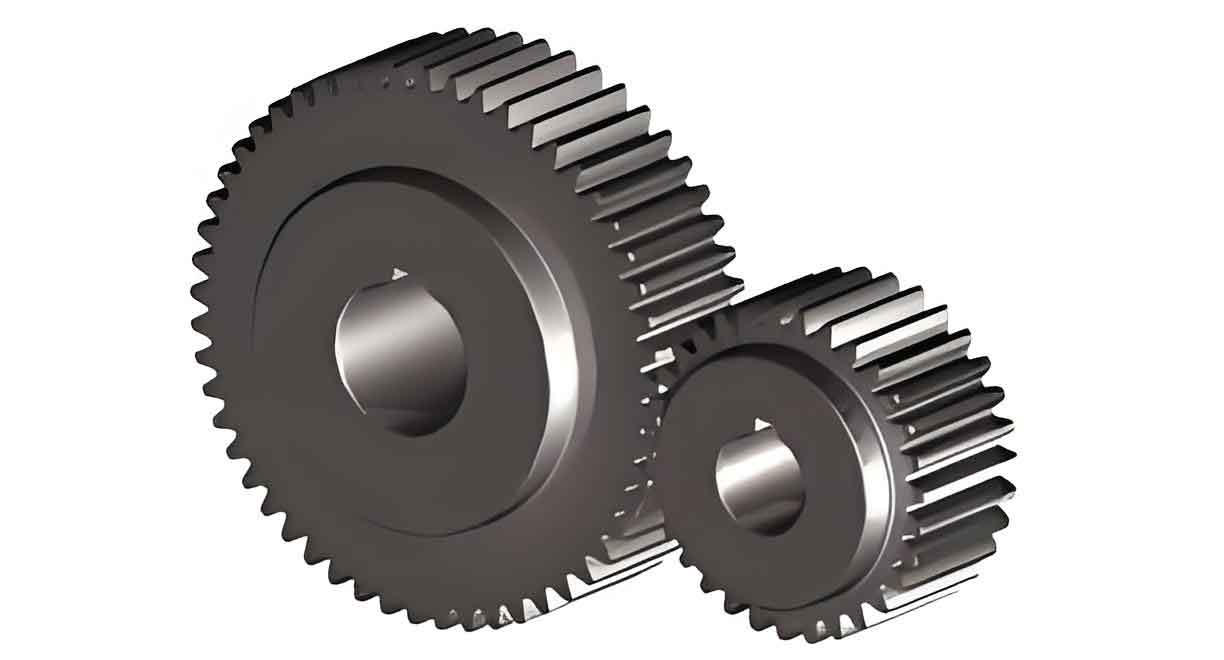This paper investigates the effects of center distance deviation on meshing stiffness and vibration characteristics of spur gear pairs through finite element analysis and transient dynamics simulations. The study establishes static/dynamic engagement models and systematically analyzes parameter influences using LS-DYNA solver.

1. Fundamental Theory
The time-varying meshing stiffness of spur gears significantly affects vibration characteristics. The transmission error (Δε) is calculated as:
$$ \Delta \varepsilon = R_{b1} (\theta_{1a} – \theta_{1b}) $$
where \( R_{b1} \) represents base circle radius, \( \theta_{1a} \) and \( \theta_{1b} \) denote actual and theoretical rotation angles respectively. Linear meshing stiffness \( K_m \) is derived as:
$$ K_m = \frac{T R_{b2}}{R_{b1}^2 (\theta_{1a} – \theta_{1b})} $$
The natural frequency \( f_0 \) relates to equivalent mass \( m_e \):
$$ f_0 = \frac{1}{2\pi} \sqrt{\frac{K_m}{m_e}} $$
with equivalent mass calculated by:
$$ m_e = \frac{I_1 I_2}{I_1 R_{b2}^2 + I_2 R_{b1}^2} $$
2. Static Meshing Characteristics
The spur gear parameters are summarized as:
| Parameter | Driving Gear | Driven Gear |
|---|---|---|
| Number of teeth | 31 | 36 |
| Module (mm) | 3 | 3 |
| Pressure angle (°) | 25 | 25 |
| Face width (mm) | 12 | 12 |
Figure 2 shows the finite element model with different center distance deviations. Simulation results reveal:
| Deviation (mm) | Single-tooth RMS Stiffness (N/mm) | Double-tooth RMS Stiffness (N/mm) |
|---|---|---|
| 0 | 154,886 | 201,578 |
| 0.06 | 141,105 | 171,055 |
| 0.12 | 132,674 | 141,733 |
The meshing stiffness decreases with increasing deviation, particularly in double-tooth engagement regions. The stiffness reduction rates are:
$$ \text{Single-tooth: } 9\%/\text{0.06mm} $$
$$ \text{Double-tooth: } 15\%/\text{0.06mm} $$
3. Dynamic Vibration Analysis
3.1 Center Distance Deviation Effects
Dynamic transmission error shows nonlinear relationship with deviations:
| Deviation (mm) | Vibration Amplitude (μm) | Fluctuation Increase |
|---|---|---|
| 0 | 19.2 | – |
| 0.06 | 24.9 | 29.7% |
| 0.12 | 24.4 | 27.1% |
The critical deviation threshold is identified at 0.06mm. Beyond this value, vibration characteristics stabilize with maximum fluctuation maintained at:
$$ \Delta \varepsilon_{\text{max}} \approx 25 \mu m $$
3.2 Rotational Speed Influences
The resonance condition occurs when:
$$ N_1 = \frac{1}{2\pi Z_1} \sqrt{\frac{K_m(I_1 R_{b2}^2 + I_2 R_{b1}^2)}{I_1 I_2}} $$
Critical vibration parameters at different speeds:
| Speed Ratio | Meshing Force Fluctuation (N) | Transmission Error (μm) |
|---|---|---|
| 0.56n | 6,809 | 59.24 |
| n | 3,071 | 24.3 |
| 2n | 5,752 | 28.9 |
3.3 Torque Loading Impacts
Nonlinear vibration growth under increasing torque:
| Torque Ratio | Vibration RMS (g) | Frequency Multiples |
|---|---|---|
| 0.5T | 14.4 | 1×, 2× |
| 1.5T | 18.8 | 1×, 1.6×, 3× |
| 2T | 21.7 | 1×, 2.5× |
4. Conclusion
Key findings for spur gear systems:
1. Meshing stiffness decreases by 9-15% per 0.06mm deviation
2. Critical center distance deviation threshold: 0.06mm
3. Resonance speed causes 2.7× meshing frequency dominance
4. High torque induces nonlinear vibration (1.6×, 3× harmonics)
The proposed methodology provides theoretical foundation for spur gear design optimization considering manufacturing tolerances and operational parameters.
